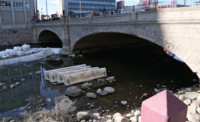An industry innovation forum in 2011 resulted in an unsolicited proposal that allowed RTD to award, in 2013, a contract for the first 12.5 miles and six stations of the North Metro Rail Line. Regional Rail Partners, a consortium of Graham Contracting Ltd., Balfour Beatty Inc. and others, is designing and building the commuter-rail line. An additional six miles of rail and two more stations will be built when funds become available.
A Kiewit-led team in 2012 submitted an unsolicited proposal to build a 10.5-mile light-rail line through Aurora along Interstate 225 for $350 million via a fixed-price contract. Previously, RTD had estimated the I-225 line would cost about $538 million. Both lines are slated for completion next year.
Staff turnover has presented continuity challenges. Dave Genova, who took the agency's interim reins from Washington after the latter recently headed to Los Angeles to lead its metro construction program (taking staffers, including Tonilas, with him), says collaboration at every level has been key to FasTracks' new momentum.
"At Union Station, we formed a project authority with the city [of Denver] and CDOT. We had 14 different funding sources," Genova says. A planned $21-million renovation of the civic-center bus station—located on the opposite end of the city's 16th Street Pedestrian Mall from Union Station—now includes "meaningful dialogue" with prequalified teams, he adds.\
Changes have been inevitable, says Greg Straight, RTD project director for Eagle P3. Last year, Denver Transit Partners (DTP)—the Fluor-led consortium building the $2.2-billion Eagle P3 project, which includes the East, Northwest and Gold lines—demolished the 555-ft-long, cast-in-place Jersey Cutoff Bridge just as it was nearing completion. Under the P3 contract, DTP is rebuilding the bridge at its own cost. "We recognized that there were deficiencies on several of the [lines' 35] bridges, but this was one of the more dramatic," says Straight. "We could have dealt with some of the needed retrofits, but those surgical fixes might have taken longer than just rebuilding the structure."
But DTP stepped up, Straight says. "Designers came up with a truly independent team to evaluate every element of the structures," he says. The bridges would not have been unsafe for the public, he notes, but they lacked the structural longevity called for in the Eagle P3 contract.
Other changes to the Eagle P3 contract included adding track and more civil work for a new East-line station. "We had to add 5,800 feet of double-track design, circuitry for signage and rework the track structure," Straight says. The new station, called the Peña Boulevard Station, was added to the line by RTD in partnership with the city, the development community and Denver International Airport (DIA) as a key step in creating a private-sector "aerotropolis" near DIA.
The new FasTracks station at the airport also has had struggles. DIA last year filed an unsuccessful lawsuit against RTD to recover $53 million in costs for sitework on the new hotel and transit center. "The two programs were not completely in sync with the schedule," says Straight. "The airport was still in the early stages of planning and didn't know the exact location of the hotel or its configuration. There were gaps between expectations, including where and how long the train platform would be."
But the teams are synced up now, he adds. Transit and airport officials met every week for more than a year to establish the sequence of work. The rail connection entailed 1.2 million cu yd of excavation for a 30-ft-deep trench that contains the 800-ft-long train platform. After arriving at the DIA train station, travelers can take an escalator that runs under the hotel
and directly into the south end of the airport terminal.
Jackie Rainey, deputy project manager for the DIA hotel and transit-center project, says airport and transit officials worked closely to "future-proof" the infrastructure. "What we can do now with our contractors here, with economy of scale, is to create future non-disruption" from additions, she says. For example, the fourth level of the 15-story hotel and transit center will be reserved for future expansion of security checkpoints. An extension built now can accommodate extra trains for a 25% capacity increase. Space also is set aside for more escalators and a future baggage-handling system near the transit station.








Post a comment to this article
Report Abusive Comment